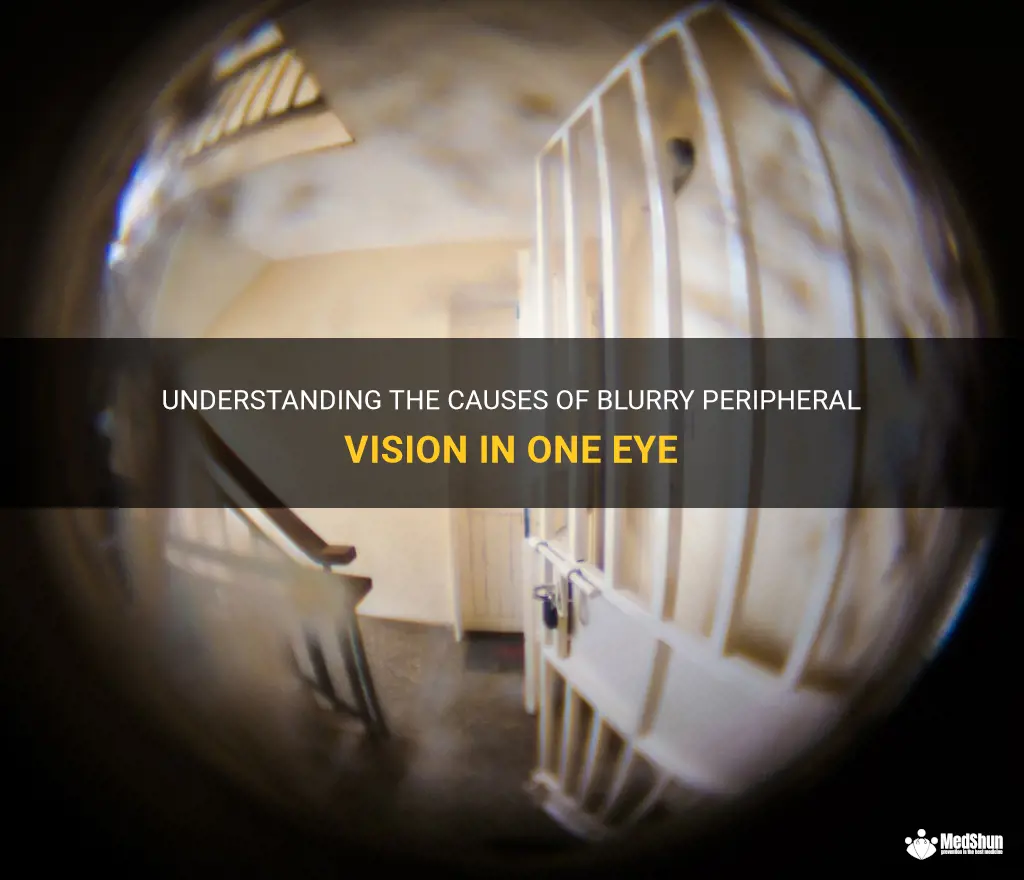
Have you ever noticed that your peripheral vision seems blurry in one eye? It can be a disconcerting and puzzling experience. Our eyes are remarkable organs that work together to provide us with a clear and detailed view of the world. So, when something goes awry and our peripheral vision becomes blurry in one eye, it's natural to wonder why. In this article, we'll explore some of the potential causes of blurry peripheral vision in one eye and delve into the fascinating intricacies of our vision system.
| Characteristics | Values |
|---|---|
| Cause | Eye injury |
| Refractive error | Nearsightedness |
| Eye diseases | Glaucoma |
| Age-related changes | Presbyopia |
| Migraine | Visual aura |
| Optic nerve damage | Optic neuritis |
| Vitreous floaters | Floaters |
| Retinal detachment | Flashes of light |
| Corneal abnormalities | Keratoconus |
| Medication side effects | Dilated pupils |
What You'll Learn
- What are some possible causes of blurry peripheral vision in one eye?
- Could a refractive error or astigmatism be the reason for blurry peripheral vision in one eye?
- Are there any medical conditions or diseases that can cause this specific symptom?
- Are there any lifestyle or environmental factors that could contribute to blurry peripheral vision in one eye?
- Should I be concerned about blurry peripheral vision in one eye and seek immediate medical attention?

What are some possible causes of blurry peripheral vision in one eye?
Blurred peripheral vision in one eye can be a cause for concern, as it may indicate an underlying health issue. There are several possible causes for this symptom, ranging from benign conditions to more serious medical conditions. It is important to consult with a healthcare professional to determine the cause and appropriate treatment for your specific situation. Here are some possible causes of blurry peripheral vision in one eye:
- Refractive errors: Refractive errors, such as nearsightedness (myopia) or farsightedness (hyperopia), can cause blurry peripheral vision in one eye. These conditions occur when the shape of the eye does not accurately focus light onto the retina, resulting in blurred vision at various distances.
- Astigmatism: Astigmatism is a common refractive error that occurs when the cornea (the front surface of the eye) is irregularly shaped, causing blurry vision in both the peripheral and central areas. This condition can affect one or both eyes.
- Eye strain: Prolonged use of digital devices, reading, or working in poorly lit environments can strain the eyes, resulting in blurry peripheral vision. Taking frequent breaks, using proper lighting, and practicing good eye hygiene can help reduce eye strain and improve vision clarity.
- Eye infections: Bacterial or viral infections can cause inflammation and blurry vision, including in the peripheral areas. Conjunctivitis, also known as pink eye, is a common infection that can cause eye redness, discharge, and blurred vision.
- Eye injuries: Trauma to the eye, such as a foreign object or impact, can result in blurred peripheral vision. Injuries can range from minor scratches on the cornea to more serious conditions, such as retinal detachment, that require immediate medical attention.
- Glaucoma: Glaucoma is a group of eye diseases characterized by increased pressure within the eye, which can damage the optic nerve and lead to vision loss. Peripheral vision is often affected first in glaucoma, causing blurry or tunnel vision.
- Cataracts: Cataracts occur when the natural lens of the eye becomes cloudy, leading to blurred vision and decreased contrast sensitivity. While cataracts typically affect both eyes, it is possible for one eye to develop cataracts more rapidly than the other, resulting in blurred peripheral vision in one eye.
- Retinal detachment: Retinal detachment occurs when the retina, the light-sensitive tissue lining the back of the eye, becomes separated from its underlying support layer. This condition can cause sudden, painless blurred vision, often starting in the peripheral areas.
- Migraine aura: Some individuals may experience migraine headaches accompanied by visual disturbances known as auras. These auras can manifest as blurry or distorted vision, often affecting one side of the visual field.
It is important to receive a proper diagnosis from a healthcare professional if you experience blurry peripheral vision in one eye. They will perform a comprehensive eye examination, including tests to evaluate your visual acuity, peripheral vision, and overall eye health, to determine the underlying cause. Treatment options will vary depending on the specific condition diagnosed.
The Colorblind Gene: Exploring which Parental Pair Could Produce Females with Colorblindness
You may want to see also

Could a refractive error or astigmatism be the reason for blurry peripheral vision in one eye?
Refractive errors and astigmatism are common vision problems that can cause blurry vision. While they primarily affect central vision, they can also impact peripheral vision to some extent.
Refractive errors occur when the shape of the eye prevents light from focusing correctly on the retina. This can lead to blurry vision at any distance and affect both central and peripheral vision. The most common types of refractive errors include nearsightedness (myopia), farsightedness (hyperopia), and presbyopia.
Astigmatism, on the other hand, is a condition in which the cornea or lens has an irregular shape, causing blurred vision at all distances. While astigmatism primarily affects central vision, it can also cause distortion and blurriness in the periphery.
In both cases, the degree to which peripheral vision is affected can vary. Some individuals may experience only mild blurriness in the periphery, while others may have more pronounced symptoms.
It is important to note that blurry peripheral vision can have various causes, and refractive errors and astigmatism are just two possibilities. Other potential causes include eye diseases, such as glaucoma or macular degeneration, as well as neurological conditions.
To determine whether a refractive error or astigmatism is the cause of blurry peripheral vision in one eye, it is recommended to undergo a comprehensive eye examination. During this examination, an optometrist or ophthalmologist will perform various tests to assess the health of the eyes and measure visual acuity. These tests may include a refraction test, in which the individual is asked to read letters or numbers from a chart.
If a refractive error or astigmatism is identified as the cause of blurry peripheral vision, corrective measures can be taken. The most common treatment option is prescription eyeglasses or contact lenses. These devices help to correct the refractive error or astigmatism, allowing light to focus properly on the retina and improving vision, both central and peripheral.
In some cases, refractive surgery may also be an option. Procedures such as LASIK or PRK can reshape the cornea to correct refractive errors or astigmatism. However, it is important to note that not everyone is a suitable candidate for these surgical procedures, and an eye care professional will determine the appropriateness on a case-by-case basis.
In conclusion, refractive errors and astigmatism can indeed cause blurry peripheral vision in one eye. However, it is important to undergo a thorough eye examination to determine the exact cause of the vision problem. An eye care professional can provide a proper diagnosis and recommend appropriate treatment options, such as prescription eyeglasses or contact lenses, to correct the refractive error or astigmatism and improve both central and peripheral vision.
Understanding the Truth about Color Perception: Which of the Following Statements Ring True
You may want to see also

Are there any medical conditions or diseases that can cause this specific symptom?
Intense itching can often be a frustrating and uncomfortable symptom to deal with. It can interfere with daily activities and even affect sleep. While there are various reasons why people experience itching, there are also specific medical conditions and diseases that can cause this symptom.
One common condition that can cause intense itching is eczema. Eczema is a chronic inflammatory skin condition that causes the skin to become red, itchy, and swollen. Itching is a hallmark symptom of eczema, and it can be so severe that it leads to scratching, which in turn can cause the skin to become damaged and further inflamed.
Another condition that can cause intense itching is contact dermatitis. This occurs when the skin comes into contact with an irritant or allergen, leading to an allergic reaction. The itching can range from mild to severe, depending on the individual's sensitivity to the irritant or allergen. Common triggers for contact dermatitis include certain fabrics, detergents, cosmetics, and certain metals like nickel.
Additionally, certain fungal infections can cause itching. Tinea corporis, commonly known as ringworm, is a fungal infection that can affect the skin, scalp, and nails. Itching is a characteristic symptom of ringworm, and it can be quite intense, especially when the infection is located in areas with thin skin, such as the groin or feet.
Scabies, a highly contagious skin infestation caused by the Sarcoptes scabiei mite, is another condition that can cause intense itching. The mites burrow into the skin, causing an allergic reaction that leads to itching. The itching can be particularly severe at night, disrupting sleep and causing significant discomfort.
In some cases, liver diseases can also lead to itching. When the liver is not functioning properly, it can result in a buildup of bile acids in the blood, which can cause itching. This type of itching, known as jaundice, is often accompanied by other symptoms such as yellowing of the skin and eyes, dark urine, and pale stools.
Lastly, underlying medical conditions such as kidney disease, thyroid disorders, and certain cancers can also cause intense itching. These conditions can affect various systems in the body, leading to changes in the skin that result in itching.
It is important to note that these are just a few examples of medical conditions and diseases that can cause intense itching. If you are experiencing persistent or severe itching, it is essential to consult a healthcare professional for a proper diagnosis and appropriate treatment. Treatment options for itching may include medications, topical creams or ointments, lifestyle changes, and addressing the underlying cause of the itching.
In conclusion, while itching can be a bothersome symptom, it can also be a sign of an underlying medical condition or disease. If you are experiencing intense itching, it is recommended to seek medical attention to determine the cause and receive appropriate treatment. Remember, proper diagnosis and management can help alleviate the discomfort and improve your overall quality of life.
What Jobs Can Colorblind Individuals Pursue in the Air Force?
You may want to see also

Are there any lifestyle or environmental factors that could contribute to blurry peripheral vision in one eye?
Blurry peripheral vision in one eye can be a concerning symptom that may have several potential causes. While it is important to consult with a healthcare professional to determine the exact cause of this issue, there are some lifestyle and environmental factors that could potentially contribute to blurry peripheral vision.
- Eye strain: Prolonged periods of staring at digital screens, such as computers, smartphones, and tablets, can cause eye strain. This can lead to a variety of symptoms, including blurry peripheral vision. Taking regular breaks and practicing the 20-20-20 rule (looking at something 20 feet away for 20 seconds every 20 minutes) can help alleviate eye strain and reduce the risk of vision problems.
- Dry eyes: Insufficient tear production or poor tear quality can cause dry eyes, which may result in blurry vision. Dry eyes can be caused by factors such as aging, medications, medical conditions, or environmental factors like dry indoor air or excessive exposure to wind or air conditioning. Using artificial tears or lubricating eye drops may help alleviate the symptoms and improve vision clarity.
- Allergies: Seasonal allergies or allergic reactions to various environmental factors, like pollen, dust, or pet dander, can cause blurry peripheral vision in one eye. Allergens can irritate the eyes, leading to redness, itching, and watery eyes. Managing allergies with antihistamines, avoiding triggers, and maintaining good eye hygiene can help reduce blurry vision caused by allergies.
- Refractive errors: Blurry peripheral vision can also be a result of refractive errors, such as myopia (nearsightedness) or astigmatism. These conditions can cause overall blurry vision, but they may affect peripheral vision more noticeably in certain cases. Wearing corrective lenses, such as glasses or contact lenses, can help improve vision clarity in such cases.
- Eye infections or injuries: In some cases, blurry peripheral vision may be a symptom of an eye infection or injury. Conditions like conjunctivitis (pink eye), corneal abrasions, or foreign objects in the eye can cause vision problems and may require medical intervention. If blurry peripheral vision is accompanied by other symptoms like pain, redness, discharge, or trauma to the eye, it is important to seek immediate medical attention.
It is crucial to remember that blurry peripheral vision can be caused by various factors, and seeking professional medical advice is always recommended for an accurate diagnosis and appropriate treatment. Lifestyle factors like maintaining good eye hygiene, using lubricating eye drops if needed, and taking breaks during screen time can contribute to overall eye health and prevent vision problems.
Understanding Color Blindness: How to Obtain a Medical Certificate Despite Being Colorblind
You may want to see also

Should I be concerned about blurry peripheral vision in one eye and seek immediate medical attention?
Blurry peripheral vision in one eye can be a cause for concern and should be evaluated by a medical professional. While it may not always indicate a serious problem, it is important to rule out any underlying conditions or eye diseases that could be causing this symptom.
There are several potential causes for blurry peripheral vision in one eye. One possibility is astigmatism, which is a refractive error that occurs when the cornea is irregularly shaped. This can lead to distorted vision, both centrally and peripherally. Another potential cause is a condition known as retinal detachment, where the retina pulls away from the back of the eye. This can cause blurred or distorted vision, as well as other symptoms such as flashes of light or a curtain-like shadow in the visual field.
Other potential causes of blurry peripheral vision include eye infections or inflammation, glaucoma, or even certain medications. It is also important to consider any recent head trauma or eye injury that could be contributing to the symptoms. However, without a thorough examination by an eye care professional, it is difficult to determine the exact cause.
If you are experiencing blurry peripheral vision in one eye, it is important to seek immediate medical attention. While it may be tempting to ignore this symptom or hope that it will go away on its own, it is always better to be safe than sorry when it comes to your vision. Only a qualified medical professional can accurately diagnose the cause of your symptoms and recommend the appropriate treatment.
During your appointment, the eye care professional will likely perform a series of tests to evaluate your vision and the health of your eyes. This may involve measuring your visual acuity, checking your eye pressure, examining the structures of your eye with a microscope, and possibly even performing imaging tests to get a more detailed look at the retina and other structures.
Once a diagnosis has been made, the appropriate treatment can be recommended. This may involve prescription glasses or contact lenses to correct refractive errors, medications to treat infections or inflammation, or even surgical intervention for more serious conditions like retinal detachment.
In some cases, blurry peripheral vision in one eye may be a temporary symptom that resolves on its own. For example, if the cause is related to medication side effects or a minor eye infection, prompt treatment can often lead to a full recovery. However, it is always better to err on the side of caution and seek medical attention, as some underlying conditions can cause permanent vision loss if left untreated.
In conclusion, blurry peripheral vision in one eye should not be ignored. While it may not always indicate a serious problem, it is important to have this symptom evaluated by a medical professional to rule out any underlying conditions or eye diseases. Only a qualified eye care professional can accurately diagnose the cause of your symptoms and recommend the appropriate treatment. Remember, early detection and prompt treatment can often lead to better outcomes for your vision.
The Impact of Refractive Disorders on Vision Loss: A Closer Look
You may want to see also
Frequently asked questions
There could be several reasons why you are experiencing blurry peripheral vision in one eye. One possibility is that you have a refractive error, such as nearsightedness or astigmatism, that is only affecting one eye. This causes light entering the eye to focus incorrectly, resulting in blurry vision. Another possibility is that you have an eye condition or disease, such as glaucoma or macular degeneration, that is affecting your peripheral vision in one eye. These conditions can damage the optic nerve or macula, leading to blurry or distorted vision. It is important to consult with an eye doctor to determine the specific cause of your blurry peripheral vision.







